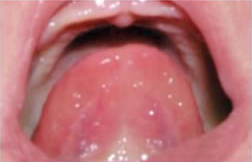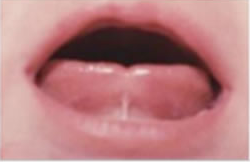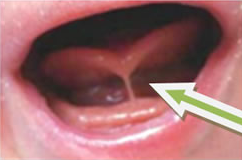What is a tongue-tie?
Almost all babies are born with a fold of tissue under their tongue called a lingual frenulum. Sometimes the lingual frenulum restricts the movement and function of the tongue. This is known as tongue-tie or ankyloglossia (pronounced ankle-o-glos-see-a). In most cases tongue mobility improves with time.
Possible signs of tongue-tie
When baby is crying you may notice:
- They are not able to lift their tongue up past the middle of their mouth.
- A ‘V shape’ or ‘heart shape’ tongue tip.



When breastfeeding you may notice your baby:
- Comes on and off the breast.
- Gets tired quickly during feeds.
- Has little or no weight gain.
Breastfeeding mothers may notice:
- Nipple pain while breastfeeding.
- The nipple looks pinched or creased when your baby comes off the breast.
- Low milk supply.
- Blocked ducts or mastitis.
If you are bottle feeding you may notice your baby:
- Swallows a lot of air.
- Gets tired quickly during feeds.
- Dribbles and leaks milk from around their mouth.
How is tongue-tie diagnosed?
It’s important to remember that many babies that appear to have a tongue-tie can still breastfeed well. Most breastfeeding problems are not caused by a tongue-tie.
If you feel a tongue-tie is affecting your baby’s feeding, seek advice and breastfeeding support from a lactation consultant or child health nurse as soon as possible.
A lactation consultant or child health nurse will complete a feeding assessment which may include examining your baby’s mouth using a tongue-tie screening tool. Your baby’s growth will also be reviewed.
If further follow-up is needed, you will be referred to your GP who can make a diagnosis and, if necessary, arrange for a surgical treatment (frenotomy).
Treatment
If your GP diagnoses tongue-tie as the cause of your baby’s feeding problems, a frenotomy can be considered.
A frenotomy is a surgical procedure where the lingual frenulum under the tongue (the ‘tie’) is released so that the tongue can move more easily. It is performed by an experienced health professional.
Talk to your doctor about whether the procedure is right for your baby. Many babies with a tongue-tie do not need a frenotomy.
Key points
- A lingual frenulum is a normal part of the mouth. It is called a tongue-tie when it affects how the tongue moves and functions
- Many babies with a tongue-tie do not need surgery.
Commonly asked questions
Will a tongue-tie affect speech development?
A tongue-tie is unlikely to cause problems with speech development. If you are worried about this you should see your child health nurse, GP or a speech pathologist.
When to seek help
If you think your baby has tongue tie, see a lactation consultant or child health nurse as soon as you can. They’ll check your baby against a list of signs and symptoms and refer you to a GP for diagnosis.
Tongue tie shouldn’t cause speech problems, but if it does, see a child health nurse, GP or a speech pathologist. #BBD0E0 »
Developed by the CHQ Breastfeeding Work Group. We acknowledge the input of consumers and carers.
Resource ID: FS295. Reviewed: June 2023.
Disclaimer: This information has been produced by healthcare professionals as a guideline only and is intended to support, not replace, discussion with your child’s doctor or healthcare professionals. Information is updated regularly, so please check you are referring to the most recent version. Seek medical advice, as appropriate, for concerns regarding your child’s health.
Last updated: October 2023